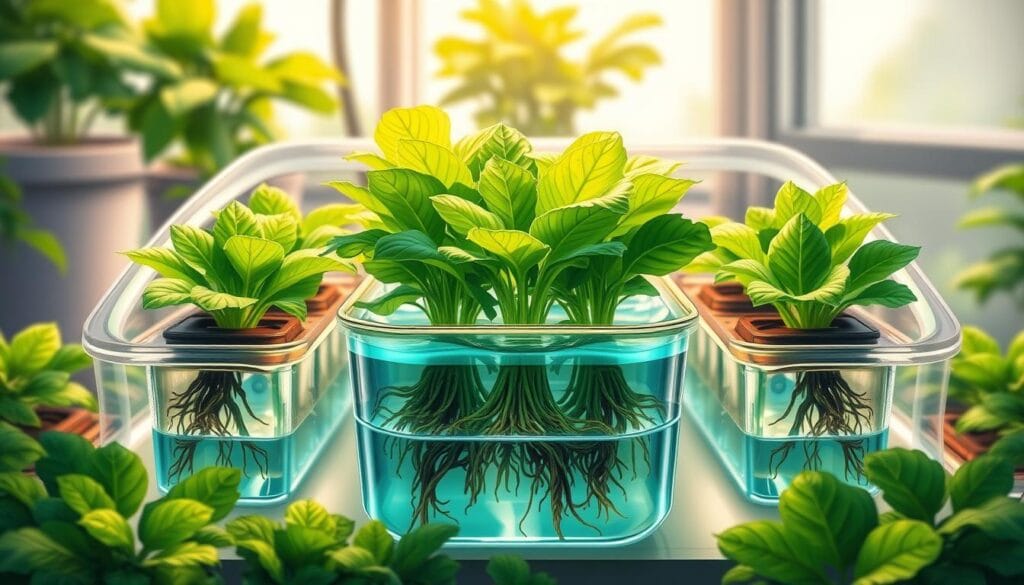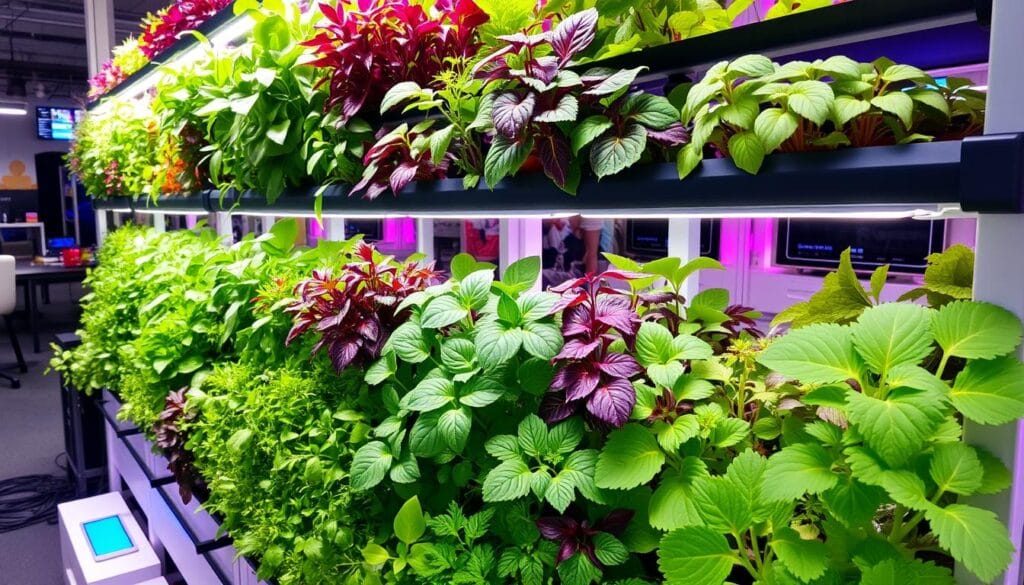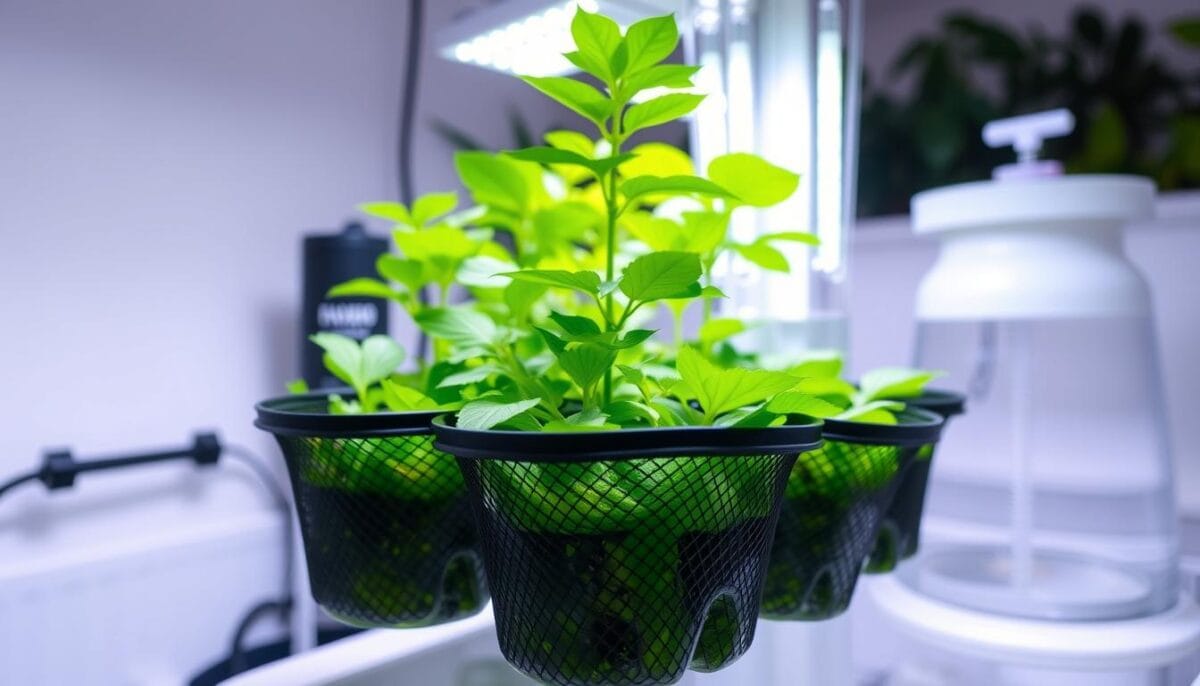Discover the power of the deep water culture (DWC) hydroponic system for your indoor garden or cannabis. This method keeps plant roots in a nutrient-rich, oxygen-filled water. It leads to quick growth, high yields, and better nutrient use. This guide is perfect for both newbies and seasoned growers. It will teach you how to set up, care for, and boost your DWC hydroponic system.
Key Takeaways
- DWC hydroponic systems provide fast growth and high yields by submerging plant roots in a nutrient-rich, oxygenated water solution.
- Efficient nutrient uptake and soilless growing make DWC a popular choice for indoor gardening and cannabis cultivation.
- This guide covers the essential components, setup, maintenance, and optimization of DWC hydroponic systems.
- Understanding the basics of DWC systems, their advantages, and potential challenges is crucial for successful implementation.
- Proper environmental control, nutrient management, and oxygenation are key factors for thriving DWC hydroponic gardens.
Understanding Deep Water Culture: Basics and Benefits
Deep water culture (DWC) is a way to grow plants without soil. Plants’ roots soak in a water solution full of nutrients and oxygen. This method uses an oxygen supply, water pump, and grow lights to help plants grow well.
How DWC Systems Work
In DWC, roots hang in a nutrient-rich solution in a reservoir. An air pump keeps the water oxygenated. This gives plants the oxygen and nutrients they need to grow fast and strong.
Advantages of DWC Growing
- Faster growth and higher yields due to optimal nutrient and oxygen availability
- Reduced water usage, as the same water is recirculated and oxygenated
- Minimal pest and disease issues in the controlled, soil-free environment
- Year-round production potential, making it ideal for urban farming and indoor growing
Limitations and Challenges
DWC systems require regular checks for optimal performance. Maintaining proper water temperature, pH, and nutrient levels is essential to prevent issues like root rot. Growers should closely monitor oxygen supply and the water pump.
Despite some challenges, DWC is excellent for growing a variety of plants, including leafy greens, herbs, and certain tomatoes and cucumbers. With the right care, DWC can yield impressive results for any grower.
Essential Components of a DWC Hydroponic System
Exploring deep water culture (DWC) hydroponics reveals a set of key components. These parts work together to create a perfect growing space. At the center is the reservoir, a container filled with nutrient-rich water. An air pump is crucial, pumping air through an airstone to keep the water oxygenated and support plant growth.
The net pots are essential for holding your plants. They’re filled with growing media like clay pebbles or rockwool. This media gives roots a solid base to grow. The nutrient solution, rich in essential nutrients, feeds your plants throughout their growth.
Choosing the right size and capacity for your reservoir is important. It must meet your hydroponic setup’s needs. With these components, you’re ready to create a DWC system that boosts plant health and productivity.
| Component | Description |
|---|---|
| Air Pump | Provides essential oxygenation to the nutrient solution through an airstone. |
| Airstone | Diffuses air from the pump, creating fine bubbles that oxygenate the water. |
| Net Pots | Containers that hold the plants and growing media, allowing roots to access the nutrient solution. |
| Growing Media | Substrates like clay pebbles or rockwool that provide a stable foundation for plant roots. |
| Reservoir | The container that holds the nutrient-rich water solution for the plants. |
| Nutrient Solution | A carefully balanced blend of essential macro and micronutrients to nourish the plants. |
With these key components in place, you’ll be well on your way to cultivating a thriving DWC system that maximizes plant health and productivity.
“A well-designed DWC system can significantly accelerate plant growth compared to traditional soil-based gardening, thanks to enhanced nutrient absorption and optimal oxygenation.”
Setting Up Your Growing Space
Creating a well-designed growing area is key for hydroponic success. When setting up your indoor garden, think about environmental controls, layout, and ventilation.
Environmental Control Factors
Keeping the right temperature, humidity, and light cycles is vital. Aim for a temperature between 68-77°F (20-25°C) and humidity of 40-60%. Use 12-18 hours of bright, high-quality lighting, like energy-efficient LED lamps, for strong growth.
Space Requirements and Layout
Your growing space should fit your plants and allow for easy maintenance. Make sure there’s enough room around the hydroponic system for tasks like checking the nutrient solution and adjusting the air pump. A well-designed space can make the most of your indoor area.
Ventilation and Air Flow
Good ventilation is key for temperature control, humidity, and air circulation. Use fans or an HVAC system for fresh air. This prevents mold and mildew and strengthens plant stems.
By focusing on these factors, you can build a thriving hydroponic space. It will support strong plant growth, efficient irrigation, and indoor gardening success.
Selecting the Right Reservoir and Container Size
When you start your sustainable agriculture hydroponic system, picking the right reservoir and container is key. These choices help your plants grow well and get the nutrients they need. Hydroponics often use food-grade, opaque containers to keep algae away and keep water clean.
For DIY deep water culture (DWC) setups, 5 to 20-gallon buckets or bins are popular. Small plants like herbs do well in 5-gallon buckets. But, bigger DWC systems need larger, stronger containers to hold more plants.
- Home gardens can use affordable, easy-to-clean food-grade buckets for a simple DWC system.
- Sturdy containers, like those made of food-grade plastic, are crucial for keeping plants safe in DWC systems.
- When you grow more plants, you need to think about how close they’ll be, the size of your containers, and how nutrients will move around.
The size of your net pots also matters for plant growth. Small net pots (2-3 inches) are good for seedlings and small plants. But, bigger pots (4 inches and up) let roots grow more, helping bigger plants and possibly increasing your harvest.
“Selecting the appropriate pot size in hydroponics is crucial for promoting root development, ensuring access to water, and optimizing nutrient absorption. It helps plants grow well and can lead to better yields.”
By picking the perfect reservoir and container size for your sustainable agriculture, vertical farming, and soilless cultivation needs, you can build a thriving hydroponic system. This system will meet your plants’ needs and make the most of this advanced growing method.

Water Quality and Nutrient Solution Management
Keeping your Deep Water Culture (DWC) hydroponic system’s water quality and nutrient solution in check is key. By watching and tweaking important factors, you help your plants get the nutrients they need. This way, they can grow as well as they can.
pH and EC Monitoring
The pH level of your nutrient solution plays a vital role in plant health. It affects how well plants can use nutrients. Try to keep the pH between 5.5 and 6.5 for the best growth. Also, check the Electrical Conductivity (EC) to make sure there’s the right amount of nutrients. The right EC level stops plants from getting too much or too little of what they need.
Nutrient Mix Ratios
Choose a good hydroponic nutrient solution and follow the instructions for mixing it. The right mix is vital for healthy plants. Think about the plant’s growth stage, water quality, and the environment when you adjust the mix.
Water Temperature Control
Keeping the water at the right temperature is important for plant roots and nutrient uptake. Try to keep it between 65-75°F (18-24°C). Big changes in water temperature can stress plants and slow their growth.
| Parameter | Optimal Range |
|---|---|
| pH | 5.5 – 6.5 |
| Electrical Conductivity (EC) | 1.0 – 2.5 mS/cm |
| Water Temperature | 65 – 75°F (18 – 24°C) |
By watching and adjusting these key factors, you make sure your DWC hydroponic system gives your plants the best chance to thrive. This leads to a great harvest.
Air Pumps and Oxygenation Requirements
Proper oxygenation is key for your deep water culture (DWC) hydroponic system’s success. The right air pump and aeration setup provide oxygen to your plants’ roots. This promotes healthy growth and prevents root rot.
When picking an air pump, look for one that can deliver at least 0.5 liters of air per minute (LPM) for every gallon of nutrient solution. This ensures enough oxygen supply and keeps root health in check. Quality air stones in your DWC reservoir help transfer dissolved oxygen to the roots efficiently.
Bigger hydroponic systems need more powerful air pumps for good oxygenation. It’s smart to have a backup air pump ready. This ensures your plants’ roots always get the oxygen supply they need.
Keep an eye on your air pump and air stones regularly. Check for clogged lines or malfunctions and fix them fast. This keeps dissolved oxygen levels high and supports your plants’ growth.
“Proper oxygenation is the foundation of a thriving hydroponic system. With the right air pump and aeration setup, you can ensure your plants’ roots receive the oxygen they need to reach their full potential.”
By following these tips and keeping your DWC system well-oxygenated, you’ll create a great environment. This environment will nurture your plants’ root health and support their growth and productivity.
Growing Media and Net Pot Selection
When setting up your deep water culture (DWC) hydroponic system, picking the right growing media and net pots is key. They help support healthy root growth and plant health. Common options for growing media are clay pebbles, rockwool, and coco coir.
Types of Growing Media
- Clay Pebbles: These are porous, lightweight clay balls. They offer great aeration and water retention for roots. Clay pebbles, or hydroton, are a reliable and reusable option for DWC systems.
- Rockwool: This mineral-based medium holds water and air well. It’s perfect for DWC. Rockwool gives roots a stable and supportive environment.
- Coco Coir: Made from coconut husks, coco coir is sustainable and renewable. It keeps moisture well while allowing oxygen to reach roots.
Net Pot Sizes and Options
| Growing Media | Advantages | Disadvantages |
|---|---|---|
| Clay Pebbles (Hydroton) |
|
|
| Rockwool |
|
|
| Coco Coir |
|
|
Choose your growing media wisely. Make sure it’s sterilized and conditioned before use. This will give your DWC hydroponic system a clean, healthy start.
Plant Selection and Growth Stages
Choosing the right plants is key to success in hydroponic gardening. Start with plants like leafy greens, herbs, and green onions. These plants grow rapidly and are simple to maintain.
The hydroponic system you pick affects your plant choices. For example, NFT systems work well with plants like lettuce and herbs. These plants grow quickly and can be ready to eat in weeks.
As you get more experience, you can grow a wider variety of plants. DWC systems are great for plants like kale and basil. Flood and drain systems are versatile and can grow many types of produce.
It’s important to watch your plants grow. From seedling to vegetative stage and flowering stage, adjust their food and light. This care will help your plants grow well and give you a great harvest.
| Plant | Recommended Hydroponic System | Growth Cycle |
|---|---|---|
| Leaf lettuce, herbs, green onions | Nutrient Film Technique (NFT) | 3-4 weeks to harvest |
| Basil, kale, butterhead lettuce, romaine lettuce | Deep Water Culture (DWC) | 4-6 weeks to harvest |
| Strawberries, tomatoes, peppers, herbs | Flood and Drain (Ebb and Flow) | 6-10 weeks to harvest |
By picking the right plants and watching their growth, you can have a thriving hydroponic garden. It will give you a lot of fresh, tasty produce.

“Hydroponic gardening can produce flavorful and nutrient-dense crops, even in limited spaces.”
Monitoring and Maintaining Your DWC System
Maintaining a healthy Deep Water Culture (DWC) system requires regular checks and care. Daily and weekly tasks are essential for optimizing nutrient levels, pH balance, root health, and overall plant growth.
Daily Maintenance Tasks
Start by checking the water level in your reservoir and add more if it’s low to maintain the proper depth. Next, test the pH and EC levels, adjusting the nutrient solution as needed. Inspect your plants for any signs of stress, pests, or nutrient deficiencies to catch issues early.
Weekly System Checks
Perform a weekly maintenance routine for your hydroponic system. Change the reservoir water, clean the container and air stones, and trim any unhealthy roots. Check nutrient levels and adjust the feeding solution to keep your plants healthy and thriving.

